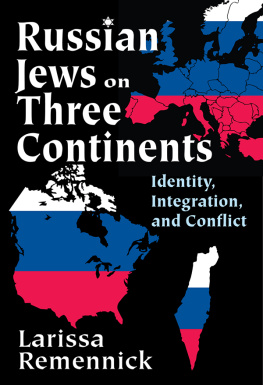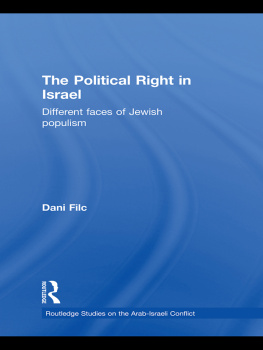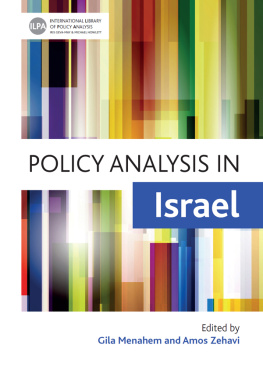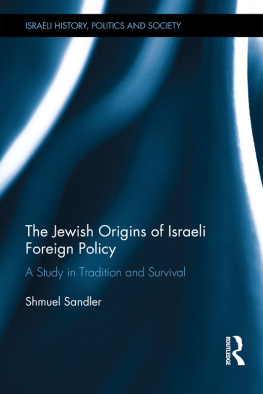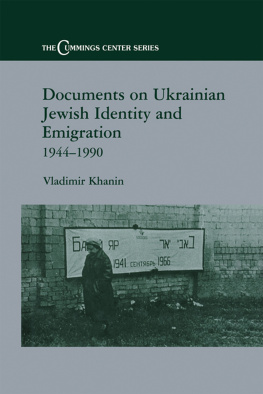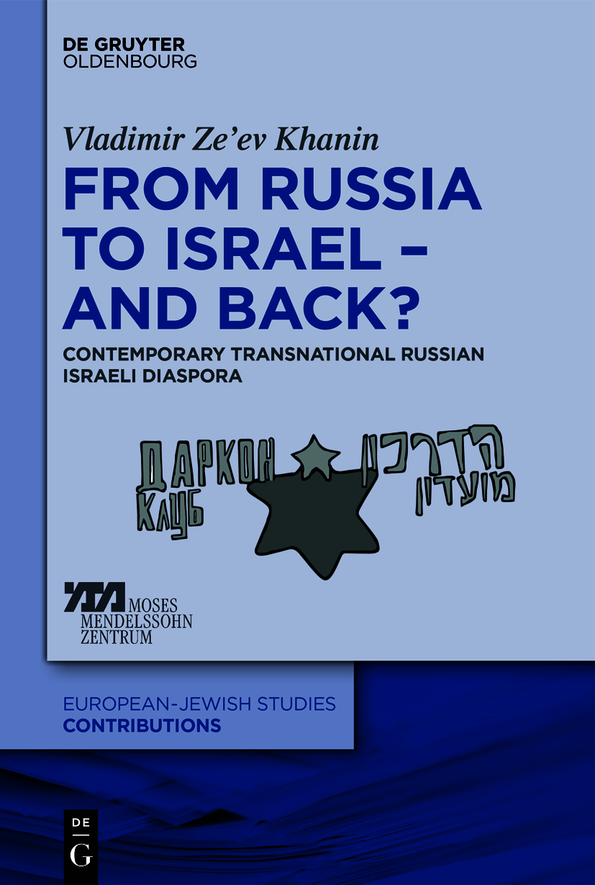Europisch-jdische Studien Beitrge / European-Jewish Studies Contributions
Edited by the Moses Mendelssohn Center for European-Jewish Studies, Potsdam
Edited by
Werner Tre
Volume
ISBN 9783110665161
e-ISBN (PDF) 9783110668643
e-ISBN (EPUB) 9783110665208
Bibliographic information published by the Deutsche Nationalbibliothek
The Deutsche Nationalbibliothek lists this publication in the Deutsche Nationalbibliografie; detailed bibliographic data are available on the Internet at http://dnb.dnb.de.
2022 Walter de Gruyter GmbH, Berlin/Boston
Chapter 1 Introduction
The modern period in the history of Israel has been marked by a crisis in melting pot ideology and practices, as well as final adoption of the norms and principles of multi-culturalism in Israeli society. This, in turn, led to the formation, or strengthening, of the diverse types and models of Israeli identity. In fact, this is true not only for relations between various ethno-confessional groups of Israelis, but also for the situation inside the Israeli Jewish community.
Recent decades have witnessed the formation in Israel of relatively new culturally identifying communities that have acquired their structures in Israel both on the basis of close-knit groups of repatriates (olim, literally meaning ascenders, in Hebrew Jewish returnees from the diaspora to their historical homeland) and their descendants representing certain Jewish communities of the diaspora, and also in the wake of growing diversity of the Israeli social organism structure. Many of these communities, whose existence is completely legitimized in todays post-modern Israeli society, are characterized by high-level stability. Israeli identity models associated with them are transmitted not only through generations but in some cases get preserved for a long time or even permanently among many of those who emigrated from the country at different times.
Unlike other groups of Jewish emigrants from Israel, a practically unexplored example of this process are Russian-speaking Israelis, including those who arrived in the country as a part of the last two waves of mass aliya (Jewish repatriation, literally meaning ascent [to the Land of Israel]) from the USSR and post-Soviet countries, but who left Israel for different reasons.
Soviet and Post-Soviet Jewish Emigration and Formation of Russian Jewish Community in Israel
More than a million-strong community of Russian-speaking Israelis, the bulk of whom arrived in the country from the territory of the former USSR with the Great Aliya (Jewish repatriation) in the 1990s, left a huge impact on various aspects of Israeli socio-political, cultural, and economic life. Their arrival coincided with the final legitimization of the idea of multiculturalism in Israel, and to a large extent contributed to the legitimization of the identity and institutions of the Russian-Jewish-Israeli community. Israeli society and its cultural and political establishment reacted relatively calmly to the emergence of a Russian ).
The first factor was an unprecedented increase in the number of Russian-speaking Israelis. According to official data, over 1.133 million Jewish people and their families arrived in Israel from the USSR and post-Soviet countries from September 1989 to January 2020. Given the natural population fluctuations, fertility (over 300,000) and mortality (approximately 130,000), as well as emigration from the country (over 120,000), the Russian-speaking community of Israel still amounted to over 1.1 million people at the beginning of 2020. In addition there are, according to our estimates, about 3540,000 people of 174,000 repatriates who arrived from the USSR during the previous aliya wave from the USSR from 1969 to 1988 who were alive by early 2020 and consider themselves part of the Russian-speaking community of Israel. Also, in Israel there are currently about 4,000 people who were born in the former USSR but repatriated to Israel from third countries and therefore are not considered Russian-speaking Israelis in the official statistics.
The most important condition for the structuring of this community into a certain communal and (sub-)cultural framework was and is concentration of a significant part of new immigrants in relatively few Israeli cities. These are Ashdod, Ashkelon, Haifa, Bat-Yam, Beer-Sheva, Netanya, Jerusalem, Tel-Aviv, and some others, where they are represented by large communities (from 40,000 to over 60,000 people). In 30 cities, Russian-speaking repatriates make up more than a fifth of the population, including 10 cities (Ashdod, Bat-Yam, Ashkelon, Kiryat-Yam, Arad, Maalot-Tatshikha, Ariel, Sderot, Katsrin, and Bnei-Aish) where their share in the population exceeds one third, and two cities (Ariel and Nof Ha-Galil) where the share of Russian-speaking citizens is already more than 40% ( This situation naturally led to the effect of cultural self-sufficiency and creation of psychologically comfortable conditions for the preservation and reproduction of familiar social, cultural, professional, and consumer standards of behavior in regions of high concentration of new repatriates.
One manifestation of this trend was the emergence of a wide self-help infrastructure in culture, education, vocational orientation, and social security, as well as the Russian business sector. This sector included hundreds of food and book stores, Russian restaurants and cafes, medical offices and law firms, construction and consulting companies, clubs, classes, hairdresser salons, interest groups and kindergartens, advertising and travel agencies, etc., and in recent years, start-up companies and hi-tech firms. And at different stages of its development, this sector, according to ).
Various studies conducted at the end of the last decade and in this decade showed that even 1525 years after the beginning of the Great Aliya, Russian-speaking repatriates still preferred to live in immigrant districts, and this trend was more noticeable among young people of 1829 years of age. And 7090% of respondents said that at home, they speak either two languages or Russian only (). In addition, a 2011 study demonstrated that at least four out of five of respondents closest friends are repatriates or children of repatriates from the former USSR and post-Soviet countries. In fact, among young people aged 1828 this figure was 3.6. More than 57% of representatives of this age group said that four or all five of their five closest friends came from the former USSR versus almost 70% of 3044-year-olds and more than 80% of middle-age and old people.
This however does not keep them from feeling quite comfortable in a different environment. According to the same survey, 90% of young people say they speak Hebrew well or fluently, while the portion of young respondents actively involved in social relations with native Israelis and repatriates of non-Russian origin was more than 57%, which is twice higher than the average (28.1%) and four times higher than among older repatriates (14.3%).
The third factor was the use by the natives of the former USSR in Israel of the Russian language as an important community symbol, as well as a living and legitimate means of communication and identification, along with its Israeli version, which, according to experts, is already significantly different from the Russian language of Russians (, 6), Russian is no longer their native language but rather their heritage language.
The critical question for any immigrant community is whether these steps meet future needs of the language market. According to the large-scale studies of Russian-speaking Israelis in 20112013, the answer to this question is apparently positive. Thus, according to these studies, from more than a third to almost half of the repatriates from the former USSR prefer to use Russian, or another language of the country of origin, exclusively for family communications, while another quarter prefer to use it as their main language of family communications. From one fifth to about a quarter of the participants in these studies said they use Hebrew and the language of their country of origin to communicate with close relatives, and only 1012% use only or mostly Hebrew. These naturally made twice the average number in both cases among young people aged 1829, while among people over 60/65 years old who interact with relatives and friends only, or mostly in Hebrew, they were absent completely. Nevertheless, a high proportion of young respondents who claim Hebrew and Russian as equal languages of communication at their homes confirms the opinion of researchers about the actual formation of sustainable Russian-Hebrew bilingualism not only among young repatriates who arrived in the country relatively recently, but also among the one and a half generation that repatriated here in preschool or early school age.



